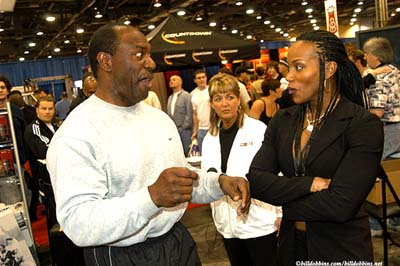Explore The Bill Dobbins Female Physique Webzine/Gallery
THE ARNOLD WEEKEND 2004
Columbus, Ohio - March 5-7
Introduction
The Expo
Lighting
Ms. International
Fitness International
Figure International
Conclusions
I've been going to Columbus to attend Jim Lorimer promoted bodybuilding
events since 1979, well before he got together with 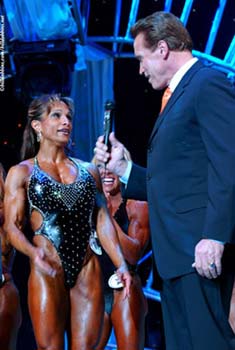 Arnold Schwarzenegger
to create the extravaganza that the Arnold Fitness Weekend has become.
Although Arnold's name is on the event, and he has been an enormously important
part of it's success, he is quick to give credit to the energy
and organizing skills of his partner Jim Lorimer. Here is what the
Arnold Weekend website has to say about Jim:
Arnold Schwarzenegger
to create the extravaganza that the Arnold Fitness Weekend has become.
Although Arnold's name is on the event, and he has been an enormously important
part of it's success, he is quick to give credit to the energy
and organizing skills of his partner Jim Lorimer. Here is what the
Arnold Weekend website has to say about Jim:
Technically, Jim Lorimer is Arnold's partner in Classic Productions, the company that produces all the Arnold Fitness Weekend events. But, Jim is more than that. Jim and Arnold began a relationship more than 25 years ago when Arnold first competed, and won, in Columbus. Arnold told Jim that when he was finished competing professionally he would come back to Columbus and hold his own bodybuilding competition. He made good on his promise.
Over the years, the weekend has evolved into a superb, exciting and hugely well-attended celebration that virtually takes over downtown Columbus one weekend a work. It is the second largest event that Columbus is host to each year, only being outdone by the horse show. ("I don't mind the horse show having a larger attendance," Arnold said some years ago, "since they have much bigger competitors.")
The Arnold Expo has become an integral and important part of the entire Weekend experience in Columbus. Once upon a time, the Expo was held at the Veteran's Memorial Auditorium, where the finals of the physique competition are staged. But a few years ago it outgrew the original venue and moved to the Greater Columbus Convention Center, where it already threatening to overflow even that huge facility. There is such a large attendance that it can take hours to make even one complete circuit of the sponsor booths - much less to check out the strength, martial arts, gymnastics, arm wrestling and other competitions and exhibitions that also take place at the Convention Center.
Mr. Olympia Lee Haney
and Ms. Olympia Lenda Murray at the Expo
|
Prejudging for the women bodybuilders, fitness and figure competitors takes place at the Expo on Friday. Since these contests take place in the Expo hall, spectators have to put up with the fact that the lighting is somewhat flat and it's difficult to fully appreciate the quality of the physiques. But all these events are free for anyone with an Expo ticket and you can combine watching these competitions with perusing the various booths and checking out all the other events taken place in adjacent halls so most of the audience seems to think the trade-off is justified.
For those who are true fans of physique women, the Expo is a good place to meet them up-close-and-personal and to buy autographed photos, videos and other products they have for sale. The best day for this is Saturday, since the competitions for women are over Friday night, which frees them up to attend the Expo the next day. Some who are not competing are at the Expo on Friday and some are also at the Expo on Sunday, but Saturday is when you can expect the most of your favorites to be on hand.
THE LIGHTING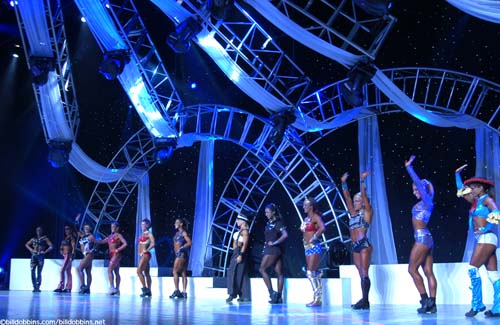 |
Fancy lighting - but
can you see the physiques?
|
Over the years, I have had few criticisms of the Schwarzenegger/Lorimer physique productions in Columbus - except for the lighting. Once upon a time, the problem was lighting at the Veteran's Memorial Auditorium that was overly "theatrical" - hot lights positioned too high so that they created too much contrast and made the physiques difficult to see, much less photograph. Nowadays, the lighting problems are created by a hot-shot lighting company which seems more interested in showing-off their technical ability than in lighting the stage so that the judges, audience and photographers can actually see what the physiques of the competitors look like. It isn't that these lighting people don't know how to light - what they don't know is what bodybuilding lighting is supposed to look like, and why. They don't seem to understand that the quality of the bodybuilding physique is in the details and if you can't see these details you are missing the most exciting aspect of the competition.
Years ago I read a science fiction story about a future astronaut who was blown to pieces in a deep space accident but was discovered and put back together by an alien race with an incredibly advanced medical technology. However, the world was horrified when he was finally returned to Earth because, with all their technical skills, the aliens didn't know what a human being was supposed to look like and had his parts all in the wrong places. That's what the lighting looked like in Columbus - despite all their technical ability the lighting people didn't know what a bodybuilding contest was supposed to look like.
The lighting for the women was too dark - about a quarter of what it should have been, there weren't enough highlights on the muscles to really make them "pop" and they were constantly bathed in distracting blue and red lights. As a result, there wasn't much applause when the women bodybuilders did their posing. No wonder, since the audience couldn't see enough muscle to allow them to get excited.
Of course, the women's lighting was far better than that to which the men were subjected. The men began their routines in the dark and the lights were gradually increased as they posed. That meant half their posing was done in the dark! Plus there were all sorts of distracting lights, of various colors, flashing on and off their physiques. One excuse I heard was that the lighting was done for television. Well, there was no TV broadcast of the women's competition and from what I saw the TV images of the men were simply dark, confusing and largely awful. What a terrible thing to do to the competitors, the judges, the audience, the media and especially the pay-per-view television audience.
As I've said over and over, the way to light bodybuilding (as is done by Mike Neveux at the Iron Man) is in a way that insures you get perfect pictures from still cameras. Film cameras require the best lighting and if your lighting is good for photos it will be best for the judges, the audience and even television. The lighting people should never consider themselves the "stars" of the event and ruin it for everyone else. I can only hope Jim Lorimer got enough complaints and could see for himself how bad the Arnold Classic looked on television so that he fires their asses without delay.
THE CONTESTS
THE MS. INTERNATIONALThe Ms. International has become the second most prestigious title in IFBB pro bodybuilding for women. This is an invitational competiton - as are the Fitness and Figure International. Since the bodybuilders don't have to qualify as they do at the Ms. Olympia, the field sometimes tends to be vary quite a lot both in its make up and quality. But the Ms. International 2004 had one of the strongest lineups in recent years.
The women compete in two weight classes, rather than the three that are authorized by IFBB rules. This is done to limit the number of competitors to free up time and money to accommodate the two other types of female physique contests. But body size is an extremely important aspect of bodybuilding competition (note: bodybuilding for men would well be advised to go back to the weight classes they abandoned after 1979) and both the Ms. International and Ms. Olympia would be improved by having three classes instead of two.
One improvement we saw at the Ms. International was the addition of the front and rear lat spreads to the mandatory poses - following the lead of the NPC, where lat spreads have been included since the beginning of 2004. I have described how these poses came to be dropped in the first place elsewhere on this website but why it took so long to restore them is a mystery. But it's nice to see that this instance of gender discrimination has finally been rectified.
The Lightweights
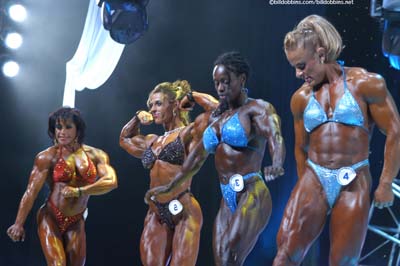 |
The lightweight posedown
|
It's always gratifying when you see bodybuilders who keep improving year after year, contest after contest. So it was a distinct pleasure to watch the lightweights as they posed in prejudging and in the finals because virtually all of them showed this kind of developmental progress.
Dayana Cadeau, the class winner, should be a primary role model for bodybuilders trying to change their physiques to become champions. Dayana began competing as an amateur in Canada in 1992 and was accepted as an IFBB pro in 1997 after winning the heavyweight and overall Canadian Championship. That same year she entered the Jan Tana as her first pro event and finished 10th. She won her first Ms. International title in 2001 and finally took the middleweight Jan Tana in 2003. But all through her pro career Dayana has showed continued progress, her major problem seeming to be too thick in the waist - which turned out to be more a matter of body weight than structural deficiency. When you have as much full muscle as Dayana, it is easy to look hard and muscular even when you are carrying too much body weight, which can fool you into thinking you are at your best when you are not.
At the Ms. Olympia in 2003, Dayana placed a close second to Juliette Bergmann but impressed both judges and audience by her much improved symmetry. The reason for this was simple: while she had been competing in the past at 135 pounds or heavier (Dayana is actually smaller in stature than most people think. Like Flex Wheeler, her full muscle shape makes her seem bigger than she is.) at the Olympia she came down to 127 pounds and her waist appeared tiny.
She continued working on her diet in preparation for the Ms. International and weighed in at 123 pounds, which she feels was a little bit too light - but it was a good learning experience since it's hard to know what "enough" is until you've experienced "too much." The one area in which Dayana still has room for improvement is in presentation. She is a good poser, but her "feminine" approach to displaying her physique is somewhat lacking in drama and excitement - at least to the degree that she didn't receive unanimous first places from the judges in the free posing round. But given the enormous gains she has achieved in developing and sculpting her physique, making corrections in posing should be a relatively easy task.
In any event, it's strange that the judges and the audience responded so well to Dayana and yet none of the physique magazines seem to be interested in publishing photos of her! Given how sexy most fans think she looks in addition to being such a good bodybuilder, you'd think they'd be standing in line.
And speaking of dramatic improvements as well as being sexy, 2nd place
in the lightweight class was won by Sophie Duquette of 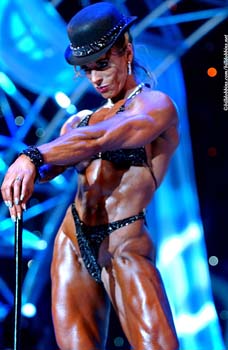 Montreal. Sophie
has not only continued to improve her muscularity and symmetry and to trim
down her waist, but she is also one of the most creative and dynamic posers
among the lightweights. Sophie has used hats, costumes and props
in her routine and has such a fun and appealing approach to presentation
that she is always an audience favorite. Finishing second at the
Ms. International 2004 is a sure sign that Sophie is on the right track
to win championships in the
near future.
Montreal. Sophie
has not only continued to improve her muscularity and symmetry and to trim
down her waist, but she is also one of the most creative and dynamic posers
among the lightweights. Sophie has used hats, costumes and props
in her routine and has such a fun and appealing approach to presentation
that she is always an audience favorite. Finishing second at the
Ms. International 2004 is a sure sign that Sophie is on the right track
to win championships in the
near future.
When you are talking about remarkable and consistent improvement, you can't leave out 3rd place Denise Masino. Lots of bodybuilders complain that they are too busy to keep up their training schedule or stay on a strict diet ("Oh, it's easy for those pros - they have nothing to do but eat, sleep and train!") but Denise manages to do this while engaged in the difficult business of running Muscle Elegance magazine and making and selling videos. Yet she has appeared on stage in her last several contests increasingly hard, defined and in terrific shape. Kudos to her.
Part of the improvement you see with Denise comes from her realization a few years ago that trying to conform to NPC/IFBB "guidelines" dictating that female bodybuilders be smaller and softer was a losing proposition. Bodybuilding is bodybuilding, and all a competitor can do is try to be the best she/he is capable of according to the long standing standards and traditions of the sport. In Denise's case, this understanding has served her well.
Fannie Barrios finished 4th in the class and there is simply nothing negative I can say about her physique, her conditioning or her presentation. Fannie is an excellent bodybuilder and has continued to make improvements in every area. The only area in which she has been criticized in the past has to do with the fact that she doesn't have "cover girl" looks. But she has even made improvements in terms of hair, make up and what is judged in bodybuilding as "overall assessment." I can only hope that whatever disappointment she feels in not finishing higher is offset by the fact that she did get an invitation to the Ms. International - something dozens of pro women did not receive - and that the judges develop a better and more realistic appreciation of her qualities..
Angela Debatin was 5th and the only thing negative you can say about Angela is she has a lot of room for improvement - that is, she has terrific potential and should keep working as intensely as possible to actualize it. Not that she looked bad, but standing on stage at the Ms. International you are in pretty fast company. Look for Angela to continue to move up in the ranks as long as she exhibits the same dedication we've seen in the four women who placed ahead of her.
The Heavyweights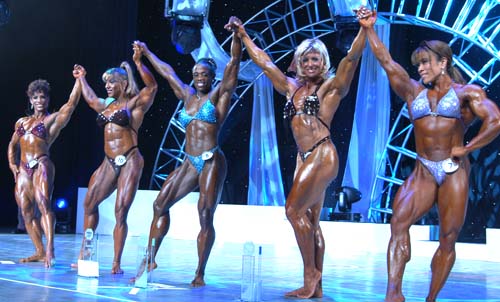 |
The top five heavyweight
winners. |
There is no doubt that, on a purely technical basis, Iris Kyle is the best female bodybuilder in the sport today. Her physique is virtually flawless, no body parts missing, especially impressive in the area of hamstrings and calves and with only rare exceptions in great shape contest after contest. I remember seeing Iris win the Orange Country Championships years ago and she was a skinny kid compared to the hard and sculpted female bodybuilders we see on stage these days.
The fact that Iris has not been able to beat Lenda Murray at the Ms. Olympia is not because her physique is in any way lacking. It has to do with uninspired presentation, a free posing routine composed mostly of compulsory poses the judges have already seen, nothing in the routine that comes across as stylish or dramatic, a tendency to pose to members of the audience off to the side of the stage instead of to the judges (who are scoring the contest at the time) and a consistent lack of publicity that comes in large part of avoiding photo sessions or setting up conditions that make having photos taken impossible. It's a shame you can be that good at bodybuilding and that poor at developing a career. Fortunately, although the IFBB have had a history of overlooking Iris, she is now getting the recognition she has earned and there was no doubt who should win the heavyweight class at the Ms. International. Since Lenda was not in Columbus, Iris' sleek, sculpted and physique was clearly deserving of victory.
Finishing 2nd was Yaxeni Oriquen, who has made considerable improvement in the past 5 years or so and has as much hard, beautifully formed muscle as anyone in the sport. The only problem with Yaxeni is that she often (as she did this year in Columbus) has a somewhat "unfinished" look. She lacks that serious level of refinement we saw in both Dayana Cadeau and Iris Kyle. I suspect she might be coming in too heavy, as Dayana used to do. But it's hard to say for sure. Certainly, coming in second at a contest as prestigious as the Ms. International is a fine achievement so Yaxeni has nothing to be disappointed about. At this point, on a purely physical basis, it would be hard for anyone to beat Iris. But Yaxeni has such a big, shapely and appealing physique is would be great to see her take it to it's aesthetic limit.
Betty Pariso placed third in the heavweights and she continues to be a wonder. The oldest female bodybuilder in the event, Betty is another competitor who manages to do all the training and diet necessary to look great on stage while helping to run a complex and demanding business. Years ago I felt Betty was not well served by her hairdo - a kind of "schoolmar'mish" look - and since then she has shown up at contests with a series of increasingly interesting looks. In this case, her sexy blond tresses were reminiscent of a 1950s glamour queen (Mamie Van Doren, where are you?) and made a great hit with everone.
Betty is also a highly entertaining poser and like a lot of older, more experienced veteran bodybuilders, is able to relax and have fun on stage, which makes for a highly entertaining routine (consider her Mike Matarazzo tribute: a most muscular pose with tongue sticking out).
In 4th place was Annie Rivieccio in her pro debut. Annie has always been a huge favorite of NPC bodybuilding audiences and when she won the Nationals and became eligible for her pro card her victory was a highly popular one. Of course, being in Columbus for your first pro show instead of, say, the Jan Tana is a big step up. But one thing Annie was not lacking on stage was muscle. If you look up the term "mesomorph" in the dictionary you'll find it is illustrated by a photo of Annie. She is solid as a rock and was in fine shape at the Ms. International. Let's just hope she is inspired by the experience to do the work necessary to work her way up through the pro ranks just as she did when she was an amateur.
Brenda Raganot, who won the lightweight
Ms. International in 2000, finished 5th in class. Brenda
has a lovely physique and is a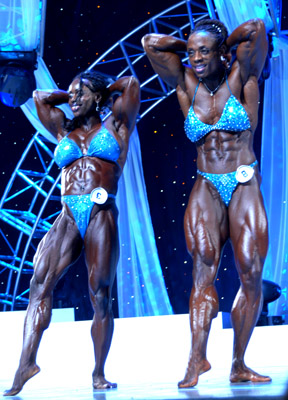 pleasure
to watch, but she needs more hard, solid muscle to compete as a heavyweight
pro. Unfortunately, the 2000 event was the one in which the (hopefully)
now defunct "guidelines" were
introduced that demanded female bodybuilders be small, soft and smooth
in order to get high marks from the judges. It
may be that what happened at that contest gave Brenda the wrong idea of
what doing your best as a bodybuilder. It is something that Vicky
Gates never recovered from. So I don't think we saw the best Brenda
Raganot possible on stage at the Ms. International, even though she certainly
has nothing to be ashamed up regarding how she looked. It's just
a matter of whether Brenda has the motivation we've seen in competitors
like Iris Kyle, Dayana Cadeau, Denise Masino and others to set herself
the goal of being the best bodybuilder she is capable of being and working
like hell to achieve it. I hope she does.
pleasure
to watch, but she needs more hard, solid muscle to compete as a heavyweight
pro. Unfortunately, the 2000 event was the one in which the (hopefully)
now defunct "guidelines" were
introduced that demanded female bodybuilders be small, soft and smooth
in order to get high marks from the judges. It
may be that what happened at that contest gave Brenda the wrong idea of
what doing your best as a bodybuilder. It is something that Vicky
Gates never recovered from. So I don't think we saw the best Brenda
Raganot possible on stage at the Ms. International, even though she certainly
has nothing to be ashamed up regarding how she looked. It's just
a matter of whether Brenda has the motivation we've seen in competitors
like Iris Kyle, Dayana Cadeau, Denise Masino and others to set herself
the goal of being the best bodybuilder she is capable of being and working
like hell to achieve it. I hope she does.
The Overall
Iris Kyle clearly and decisively beat Dayana Cadeau in the overall. The primary reason was body size - good big athlete beating a good smaller one and all that. Dayana weighed 123 lbs while Iris weighed in at 156 lbs. Seen on stage by herself or in photos, Dayana seems huge. Next to Iris she looked diminutive. The comparison between the two physiques also demonstrated the degree to which Dayana was some 5 pounds under her ideal contest weight (5 lbs being a lot when yo are dealing with such a relatively small body). But another thing that the posedown clearly demonstrated was the reason for having weight divisions in the first place. Having small statured women competing directly against the bigger ones defeats the whole purpose of bodybuilding - which is to create the ideal aesthetic muscular scupture out of whatever type of body your genetics has gifted you with. Dayana should have been a lightweight and there should also have been a true middleweight competitor in the posedown. All the more reason to have THREE WEIGHT CLASSES at the Ms. International and the Ms. Olympia and to give a wider field of women bodybuilders the opportunity to compete for a championship title against competitors of a comparable size.
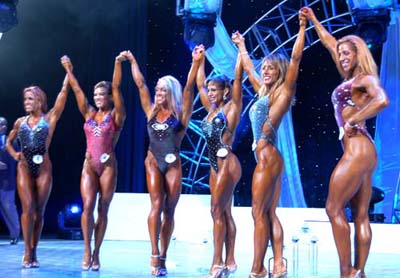 Fitness was introducted into IFBB/NPC physique competition as an
alternative to bodybuilding - and to keep pace with the fitness events staged
by the Ms. Fitness and Fitness America organizations. But there has always
been a problemmatical element to this type of contest. For example, although
they were being sanctioned by physique organizations, the ability to do gymnastics
(or something equally as demanding of prior training and expertise) has always
meant that the competitions could not be scored on the basis of physique,
so the audience could rarely tell by looking who was likely to win. What
they saw was not what they got. As a result the winners of fitness championships
have often not had the kind of bodies - or looks - that would most appeal
to the ticket-buying or magazine-reading physique audience.
Fitness was introducted into IFBB/NPC physique competition as an
alternative to bodybuilding - and to keep pace with the fitness events staged
by the Ms. Fitness and Fitness America organizations. But there has always
been a problemmatical element to this type of contest. For example, although
they were being sanctioned by physique organizations, the ability to do gymnastics
(or something equally as demanding of prior training and expertise) has always
meant that the competitions could not be scored on the basis of physique,
so the audience could rarely tell by looking who was likely to win. What
they saw was not what they got. As a result the winners of fitness championships
have often not had the kind of bodies - or looks - that would most appeal
to the ticket-buying or magazine-reading physique audience.
Additionally, the women involved in fitness often have the type of physique that gets muscular fairly easily - often too muscular for what the federations would accept in any given contest any given year. So there has never been a set "standard" for judging the physique part of fitness. Nonetheless, the competitors have gradually become more muscular over time despite the objections of many federation officials. As with bodybuilding, if people with athletic bodies do serious weight training over time they will inevitably develop more muscle mass and muscularity - even if they starve themselves and do endless cardio in an attempt to slenderize their physiques.
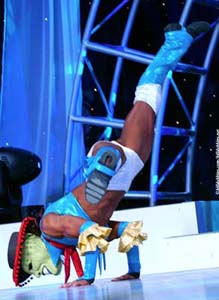 |
A good example is the 2004 Ms. Olympia Fitness champion Adela Garcia Friedmansky. Adela has always been fairly small - not to the same degree as former champion Susie Curry, but along somewhat the same lines. It is probably doubtful that Adela has made any great attempt to "get big" but over time her physique and filled out and her shape has improved. Nobody familiar with physique competition would confuse her with a pro bodybuilder but I'll bet a lot of people who see her on television or in magazine photos would make that assumption. (The "general public" has a tendency to overreact to any visible signs of muscle on the female body, unless the woman involved is a professional wrestler.) Adela still has a "fitness body" but nowadays it looks a lot more as if its the product of regular weight training, so she seems a lot more at home on the stage of a physique contest than in the past. She is also a terrific performer - not the best, but very good - and her scores given her routine combined with top placings in the physique rounds gave her victory in Columbus.
Kelly Ryan was runner up at the Ms. Fitness International
2004. Kelly is a Bela Karolyi-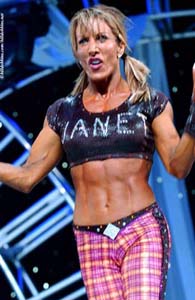 trained gymnast. She doesn't bounce around
the stage with the energy of a waterbug, as we used to see with Susie Curry,
but in my opinion she creates the most entertaining routines in fitness.
I've
often
felt that
audiences
in Vegas showrooms would pay to see Kelly's performance. The scores from
the judges indicated that they were impressed as well. But Kelly showed
up this year with a somewhat changed physique. Kelly has always looked
to some degree like a miniature bodybuilder - which physique audiences
like - but in 2004 showed up much more slender, lean and sleek. She certainly
looked good, but looking at her from 30 feet away or futher while she stood
on stage the leaner Kelly was somewhat less impressive. The judges seemed
to think so and placed her behind Adela in the physique rounds. With her
nemisis Susie Curry no longer competing in fitness it is probable that
Kelly felt this would be her year. Unfortunately, she placed a mere three
points behind Adela - which was no doubt a major disappointment to her.
I suspect she will consider putting on at least some of the muscle
she sacrificed this year in order to be more competitive in the future.
trained gymnast. She doesn't bounce around
the stage with the energy of a waterbug, as we used to see with Susie Curry,
but in my opinion she creates the most entertaining routines in fitness.
I've
often
felt that
audiences
in Vegas showrooms would pay to see Kelly's performance. The scores from
the judges indicated that they were impressed as well. But Kelly showed
up this year with a somewhat changed physique. Kelly has always looked
to some degree like a miniature bodybuilder - which physique audiences
like - but in 2004 showed up much more slender, lean and sleek. She certainly
looked good, but looking at her from 30 feet away or futher while she stood
on stage the leaner Kelly was somewhat less impressive. The judges seemed
to think so and placed her behind Adela in the physique rounds. With her
nemisis Susie Curry no longer competing in fitness it is probable that
Kelly felt this would be her year. Unfortunately, she placed a mere three
points behind Adela - which was no doubt a major disappointment to her.
I suspect she will consider putting on at least some of the muscle
she sacrificed this year in order to be more competitive in the future.
In third place was Jen Hendershott and there is no doubt that her superior gymnastic skill and ability to entertain were decisive factors in how well she did. Jen has a nice physique and she gets in top shape, but the judges preferred several other bodies to hers. But she is a delight to watch on stage and projects so much personality that she was able to outplace everone in the lineup except Adela and Kelly.
 Also in the competition were two competitors high on my list
of "fitness competitors who should be bodybuilders." One of the problems
with female bodybuilding nowadays is that a lot of women who have the genetic
gifts for bodybuilding have for one reason or another (to some degree because
bodybuilding is just too hard, but also because they have been discouraged
by the unfairly negative treatment of the sport by the federations
and the physique press) chosen a different type of competition. For example,
Tracey Greenwood has so much solid muscle - and the obvious ability to
build more - that her participation in fitness is obviously a loss for
bodybuilding. And Stacy Simons not only has muscle in abundance, but she
has the kind of fullness of shape you see in the physiques of Lenda Murray,
Dayana Cadeau - and Flex Wheeler. Another loss for bodybuilding.
Also in the competition were two competitors high on my list
of "fitness competitors who should be bodybuilders." One of the problems
with female bodybuilding nowadays is that a lot of women who have the genetic
gifts for bodybuilding have for one reason or another (to some degree because
bodybuilding is just too hard, but also because they have been discouraged
by the unfairly negative treatment of the sport by the federations
and the physique press) chosen a different type of competition. For example,
Tracey Greenwood has so much solid muscle - and the obvious ability to
build more - that her participation in fitness is obviously a loss for
bodybuilding. And Stacy Simons not only has muscle in abundance, but she
has the kind of fullness of shape you see in the physiques of Lenda Murray,
Dayana Cadeau - and Flex Wheeler. Another loss for bodybuilding.
One thing noticable about fitness these days is the seeming lack of new blood. Since the federations began sanctioning figure, the ranks of fitness have been thinning. At local NPC shows it is common to see 50 or more figure competitions but only 4 or 5 (total!) women in the fitness category. I have been recommending for years that the rules be changed in fitness to allow for a wider range of performance skills, less emphasis on gymnastics (no tumbling - it's too dangerous) and more muscular development in order to stem the mass exodus of women from fitness to figure. However, at this point it might be too late and fitness as we know it may be a dying form of competition.
THE FIGURE INTERNATIONAL
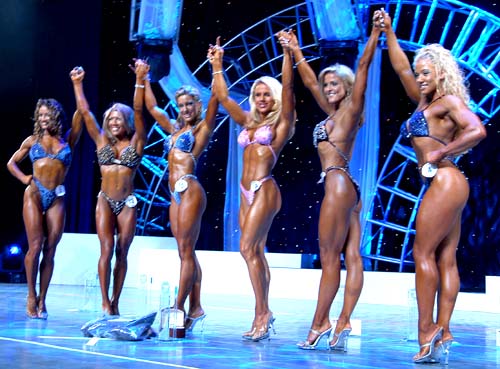 There
is little doubt that figure is in the process of rapidly replacing fitness
in both IFBB and NPC physique competition. Ever since
women bodybuilders began actually looking like bodybuilders back
in the 1980s the federations have been searching for a way to turn muscle
competitions for women into something more resembling conventional beauty
contests. After trying unsuccessfully to stifle the development of female
physique competitors, federation officials decided to adopt the fitness
format orignally created by Wally Boyco for the Ms. Fitness events. But
this format
tends
to emphasize gymnastics in the peformance round, which not only limits
participation because many would-be competitors lack the requisite lifetime
of gymnastics training, but also favors the type of body which is best
suited to gymnastics - small and compact, rather than long, lean and
There
is little doubt that figure is in the process of rapidly replacing fitness
in both IFBB and NPC physique competition. Ever since
women bodybuilders began actually looking like bodybuilders back
in the 1980s the federations have been searching for a way to turn muscle
competitions for women into something more resembling conventional beauty
contests. After trying unsuccessfully to stifle the development of female
physique competitors, federation officials decided to adopt the fitness
format orignally created by Wally Boyco for the Ms. Fitness events. But
this format
tends
to emphasize gymnastics in the peformance round, which not only limits
participation because many would-be competitors lack the requisite lifetime
of gymnastics training, but also favors the type of body which is best
suited to gymnastics - small and compact, rather than long, lean and 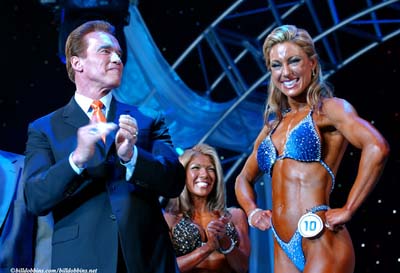 shapely.
shapely.
A major reason for subsequently creating the figure-type format of competition was the simple fact that so many women were complaining abut the emphasis of gymnastics in fitness and dropping out of fitness in increasing numbers. Originally, the concept was to have fitness contests without any performance or athletic requirement at all but in which the standard of judging physiques would be about the same. But it quickly became clear that, once you take away the performance round, the judges tended to prefer the long-legged, long-torso fitness "model" type to the shorter and more compact gymnastic body. So it was not surprising when competitors like Jenny Lynn and Davana Medina won the top pro figure competitions. If you are going to have a specialized beauty contest, in which the competitors are required to have "hardbodies" but not be too muscular, and that the emphasis will be on conventionally attractive women, it is clear that competitors like Jenny and Davana are going to have the advantage.
Davana was not in the Figure International 2004 so Jenny Lynn (predictably) ended up with first place votes from every judge in every round (as far as we can tell, since the IFBB only published cumulative scores and we don't know how each individual judge scored the event - and is that wise in an event in which prize money is awarded?). Jenny is a lovely woman with a beautiful body, and I remember noticing her back when she competed in fitness - unsuccessfully in many regards because of the gymnastics requirement. But when only quarter turns are involved, Jenny shows up in shape, looks good in both a bikini and a one-piece suit, handles herself well on stage, and also benefits from the tendency of the judges in both figure and fitness to vote for competitors again they have voted for in previous contests.
 Yet
AGAIN Monica Brant placed second in a pro figure competition. Actually,
based strictly on the criteria of having long-legged, tall proportions
Monica shouldn't
finish
anywhere
as high as second. In fact, Monica is so much not a convenional-looking
model that the could easily become a champion bodybuilder as long as the
competition featured a
true lightweight
class
(which the
Ms. International and the Ms. Olympia do not). But she does so well in
pro figure because she
looks so good! In fact, Monica Brant is in many ways the most attractive
"physique" woman in the IFBB - including bodybuilding, fitness
and figure. Monica is the Rachel McLish of her day - the muscle woman that
best appeals
to everyone, including those who like a lot of muscle, don't like too much
muscle and even to a more mainstream audience. A genuine star - as Lenda
Murray is in bodybuilding. She is so impressive standing on stage in a
figure competition that the judges
can't
score her
any lower
than the top three, even though she doesn't have the kind of proportions
that are rapidly become the judging standard. In fact, the only reason
that Monica doesn't receive more attention and promotion than she does
is because,
unlike Rachel, she tends to be a bit quiet and unflamboyant by comparison
and therefore doesn't generate the amount of publicity that she might otherwise.
But even so, Monica is pretty damn popular and deservedly so.
Yet
AGAIN Monica Brant placed second in a pro figure competition. Actually,
based strictly on the criteria of having long-legged, tall proportions
Monica shouldn't
finish
anywhere
as high as second. In fact, Monica is so much not a convenional-looking
model that the could easily become a champion bodybuilder as long as the
competition featured a
true lightweight
class
(which the
Ms. International and the Ms. Olympia do not). But she does so well in
pro figure because she
looks so good! In fact, Monica Brant is in many ways the most attractive
"physique" woman in the IFBB - including bodybuilding, fitness
and figure. Monica is the Rachel McLish of her day - the muscle woman that
best appeals
to everyone, including those who like a lot of muscle, don't like too much
muscle and even to a more mainstream audience. A genuine star - as Lenda
Murray is in bodybuilding. She is so impressive standing on stage in a
figure competition that the judges
can't
score her
any lower
than the top three, even though she doesn't have the kind of proportions
that are rapidly become the judging standard. In fact, the only reason
that Monica doesn't receive more attention and promotion than she does
is because,
unlike Rachel, she tends to be a bit quiet and unflamboyant by comparison
and therefore doesn't generate the amount of publicity that she might otherwise.
But even so, Monica is pretty damn popular and deservedly so.
In contradiction to everything I've said above about the
nature of figure, Susie Curry finished 3rd in her first pro figure contest.
I actually find it difficult to describe why I think this placing was absurd.
The main reason is that Susie is such a nice person and an outstanding
athlete that I hate to write an opinion which I'm sure is likely to hurt
her feelings. But with her slender body and stick-like legs I never understood
why Susie was able to score so well in the physique rounds of fitness.
So it seems obvious that the judges scored her so well in figure - where
having a gymnastic body is no advantage - simply because of who she is,
not what she actually looked like. Stand her next
to tall, lean Jenny on one side and aesthetically muscular Monica on the
other and you'd have to include that, at least in this case, the judges
weren't paying enough attention.
The rest of the top 6 at the Figure International confirm that the event is designed to be a beauty contest for women with good physiques - because they were all beauty and all had great looking, fit bodies.Actually, there is nothing wrong with beauty contests as long as you don't confusing them with something else. I tend to be biased in favor of female bodybuilding because it is actually a sport, and all sports focus on the extreme limit of human performance or skills - which beauty contests do not. That said, I like beautiful women as much as the next guy and my long involvement with physique publications and competitions has helped to create a preference for the fit female body. So I would be the last person to deny how attractive the pro figure women at the Arnold were or how nice it is to have a standard of female beauty being rewarded that celebrates aesthetically developed muscle.
 So
more power to 4th place Jamie Frankin for being able to stand out in a
group of the high caliber of the Arnold line-up. And 5th
place D.J. Wallis has always been a favorite of mine, so I'm pleased to
see that she has emerged in the top ranks of figure after being outclassed
in fitness due to lack of gymnastic ability. As to 6th place Mari Kudla-Donnelly,
in many ways she doesn't have that leggy-model look which is becoming the
standard for the figure physique, but she is so attractive, sexy and personable
- a muscular version of the ultimate "bikini babe" - that I'm
not surprised the judges consistently treat her well in the scoring.
So
more power to 4th place Jamie Frankin for being able to stand out in a
group of the high caliber of the Arnold line-up. And 5th
place D.J. Wallis has always been a favorite of mine, so I'm pleased to
see that she has emerged in the top ranks of figure after being outclassed
in fitness due to lack of gymnastic ability. As to 6th place Mari Kudla-Donnelly,
in many ways she doesn't have that leggy-model look which is becoming the
standard for the figure physique, but she is so attractive, sexy and personable
- a muscular version of the ultimate "bikini babe" - that I'm
not surprised the judges consistently treat her well in the scoring.
CONCLUSIONS
Fitness may be winding down to some degree, but bodybuilding for women
continues to attract a wide and devoted audience and there seems to be
no shortage of beautiful would-be figure champions. My only regret in
looking at the pro fitness and figure lineups is that, in part
because
of the
attitude
of
the federations
and
physique
publications,
so many beautiful women with the potential to be outstanding champion
bodybuilders have been steered away from the sport and have settled for
competing
in different types of "physique beauty contests". I've already pointed
out the bodybuilding potential
of Monica Brant and a number of the fitness competitors. Can you imagine
somebody has shapely and sexy as Mari Kudla-Donnelly with enough muscle
mass and
muscularity
to compete
on stage
in the Ms. International or Ms. Olympia? Perhaps when figure as been
around
longer
and the women
gradually begin to put on more size (as has happened with fitness and
as always happens when athletes engage in serious weight training over
time) there
will
be more
cross over. But that will only likely happen when the physique world
begins to comprehend how good for business that kind of change in attitude
would be
Another problem is the prize money. Anybody familiar with physique competition should know without any doubt that the intensity of effort and the many years of training it takes to be a pro bodybuilding champion is overwhelmingly greater than the amount of diet and training it takes to win a fitness or figure event (although developing a fitness routine is certainly very demanding). Nor is there any evidence that figure attracts more fans or sells more tickets than does bodybuilding. In fact, it seems to be the opposite. And yet the prize money in figure is roughly comparable to that of bodybuilding (although lightweight bodybuilding champion Dayana Cadeau made only $7000 while Jenny Lynn's prize money was $10,000 - and having had to feed Dayana during photo shoots I'm sure she spends more during the year just on buying turkey!). But Fitness International champion Adela Garcua-Friedmansky won $20,000 - $3000 more than Iris Kyle, who won the heavyweight bodybuilding class as well as the overall. In sports, athletes tend to be compensated on the basis of how much income they generate for the sport and the team. On that basis, considering not only the difficulty involved in training and diet for a specific bodybuilding contest, the many years of cumulative training it takes to become a pro bodybuilding and the fact (in my opinion, but I think in fact a truth) that the bodybuilding audience is much more willing to buy tickets to contests than are the fans of fitness and figure, women bodybuilders have earned a right to get a much larger proportion of the financial rewards than is the current practice.
